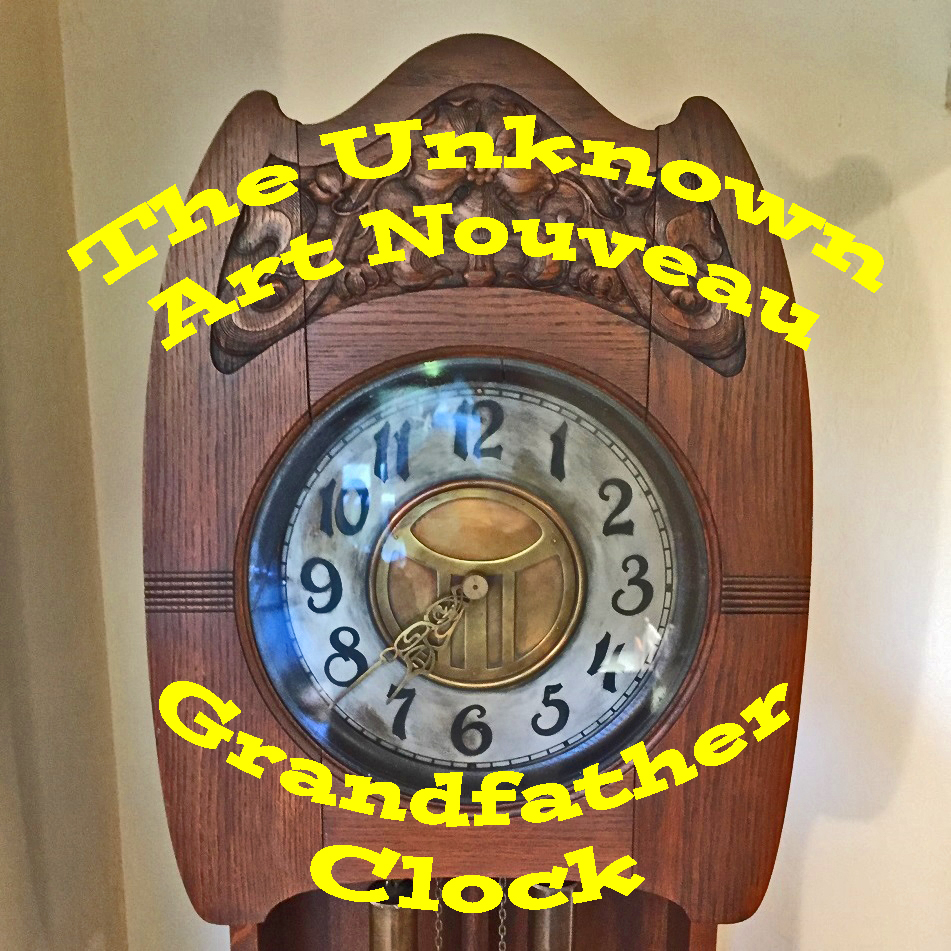
It was hiding into the corner of an estate sale. It was tall, over 7 feet, and with a style unattractive to most clock collectors. I gravitated toward the tall case clock, usually referred to as a grandfather, for its bold, non-conforming design. Even if the clock movement did not work, or was hopelessly broken, I wanted this tall case clock that had strong influences of an art nouveau design.
The small warehouse was teaming with antique clock collectors pouring over the hundreds of clocks collected, hoarded, by one couple for over 50 years. For clock nerds, it was heaven. There were plenty of excellent clocks in good shape representing a variety of different design influences: French, UK, and American. But there was the one tall case clock being summarily ignored by all the horological aficionados.
Art Nouveau Inspired Grandfather Case Design
The tall case clock I was focused on was not traditional. There were no columns or scrolls, finials or broken arches emblematic of conventional tall case clocks. The design of this piece of furniture was doing all it could not to echo the conventional tall case proportions. Of course, it had to have all the requisite design elements that make a tall case clock functional. The clock movement itself had to be supported a sufficient distance from the floor to allow the weights to fall, powering both the time and hourly strike mechanisms.
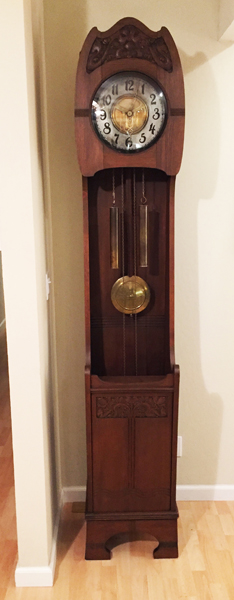
What struck me from the side view, was that the case was designed to present the clock dial like a stem supporting the flower of a spring daffodil. In particular, the dial door does not have one square angle to it. While symmetrical, it is oblong, with plenty of curves, like one might see on a flower. Another floral presentation element are the three arches on both sides of the hood enclosing the clock movement. The openings between the arches are covered with fabric and are there to allow the gong strikes indicating the hour and half hour to resonate out to be heard.

The clock is known as an open well or open wag design. This means it has no front door on the trunk that encloses the weights and pendulum. As the weights drop from powering the clock movement, they slowly descend into the well. This well section grows from 11 and ½ inches at the base up 13 and ¾ inches, over a 27 inch rise, to the top of the well. This is approximately a 4 degree opening up of the well. From the side, the enlarging well breaks up the vertical line and adds to the visual playful nature of the clock.
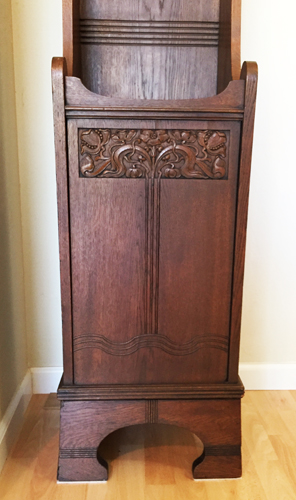
On the front of the well, near the bottom, are tree horizontal undulating lines. This, I assume, is to convey an aspect of water. Three lines, perpendicular to the water lines rise up and become the stems of vines and flowers in a rectangular tablet. The floral design on the well echoes the flowers on the top of the dial door. To me, the most recognizable flower seems to be a dogwood bloom.
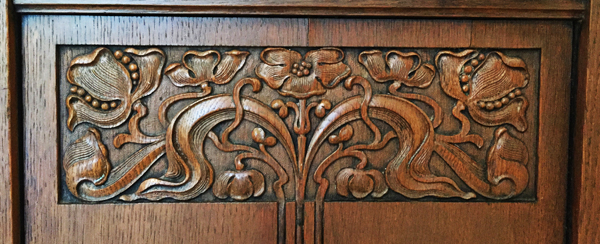
The only other floral embellishments on the clock are a rosette of leaves on both sides of the well. There are some other groupings of vertical lines on the base, inside well below the pendulum, and on the clock dial door. These stiff lines of geometry may seem to be odds with the overall organic design of the clock, but I find them interesting and not a distraction.
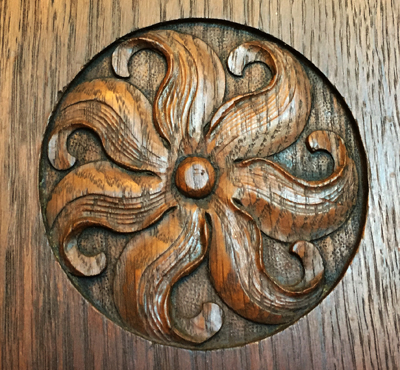
I called this the Unknown Art Nouveau Tall Case Clock because despite my best historical research efforts I have been unable to definitively attribute either the clock movement or the case to a specific company or designer. However, the clock design is infused with elements that appear to be both art nouveau and shades of the arts and crafts movement from the end of the 19th century. The case, except for the veneer on the back, is solid oak. From an inspection of the clock to put it in running order, the original walnut or dark stain has been stripped off and a lighter color stain applied.
Flower Presentation Clock Dial Door
Another aspect of the clock that struck me was the pendulum and dial motif. While not an exact duplicate, the symbols impressed on the dial and pendulum are similar. They almost look like a mathematical symbol like pi or emblem for a secret society like the Free Masons. Perhaps this was a holdover from the earlier design influence of the arts and crafts movement. Certainly, one could argue that the overall design of the clock incorporates elements of both design philosophies.
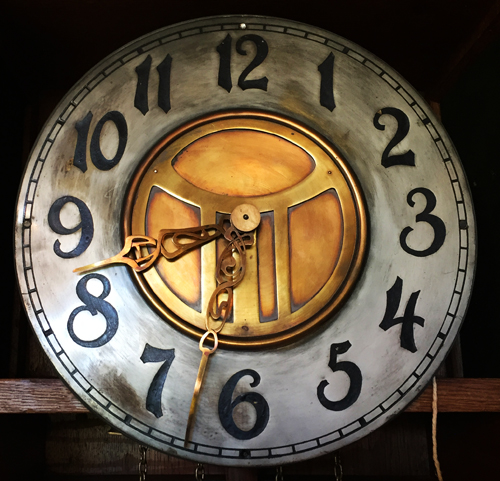
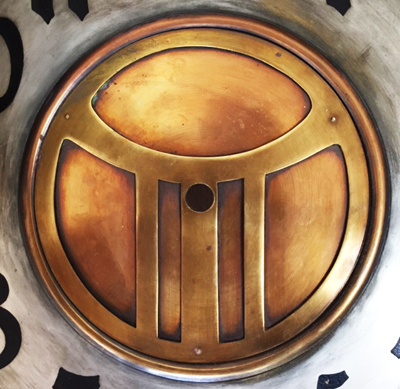
The pendulum bob with the embossed symbol is not very solid. The small finishing nails that keep the front and back halves together are loose. This has allowed the bob to move back and forth scraping the wooden rod. It is not perfect, but it works. The symbol on the pendulum bob evokes horizontal lines of water and flowers or trees growing vertically.
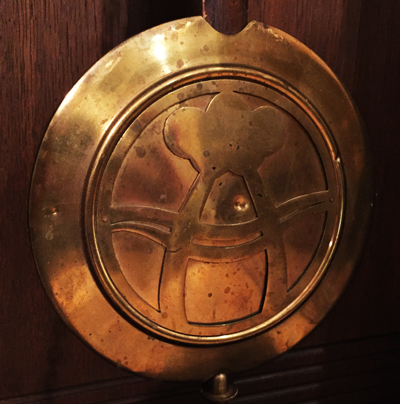
My best guess of the manufacture of this clock from its design and construction is between 1905 and 1910. This would put it squarely in timeframe when consumer items were being constructed with the modern design influences of the time. In addition, because of the open well design, there is a strong probability that it was manufactured in Germany.
The minute and hour hands, from my perspective, strongly correlate with art nouveau as they both show the whiplash lines of vines. The ends of each hand are gently curved toward the dial. The door had a piece of flat glass inserted between the frame and interior bezel. Most knowledgeable clock folks I spoke with suggested a clock of this nature usually had convex glass. This would make sense because the tips of the hour and minute hand are curved.
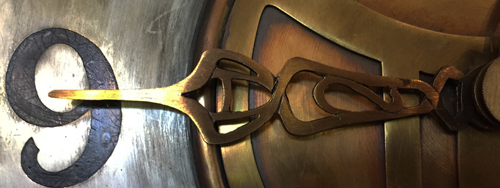
The curved glass and hands would make another gentle gesture of harmony and nature. I did purchase a piece of convex glass and mounted it on the dial door. I also had the movement reconditioned – it was in good working order when I bought it – removing the decades of old oil and dirt from the wheel gear arbor pivots.
The dial itself, to me, is striking with a center of brass coloring and embossed symbol, black waxed Arabic numerals and chapter ring, and silvered plate surrounding them. I can’t really determine if there was a specific design inspired font for the numbers or not. When new, the contrasting colors and dark numerals would have really popped out.
The dial door and hinges have been reworked or repaired. As acquired, the door was off center by about ¼ of an inch. This meant that when the door was closed, the minute hand of the clock would be over the interior bezel, preventing the door from being opened. I made some adjustments to the hinges, which I do not believe are original, to allow the door to be closer to center line of the dial and not interfere with the minute hand.
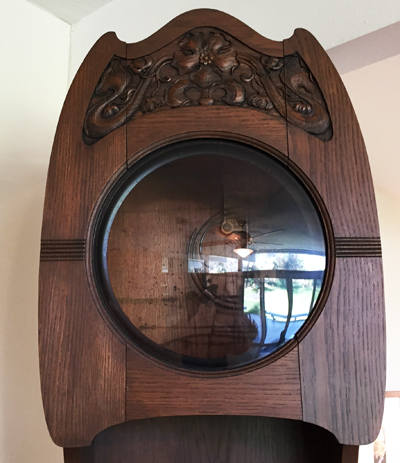
There also seems to be some quarter round molding added to the interior surrounding the fabric on the left side gong opening. This wood, not found on the right-side gong door, pushes the seat of the movement slightly to the right. The result, as near as I can reckon, was a dial door that was stressed when closed leading to a separation of the oak sections. Consequently, the seams of the four different pieces of oak that comprise the door are visible.

I’m not certain if the different parts of the door, with opposing grain patterns, was a design element or not. The sides have the grain running vertically, while the top and bottom pieces run horizontally. This may not have been apparent when the clock had a darker stain color, but the lighter stain makes the opposing grain pattern stand out to the viewer. This opposing grain pattern, with different shrinking and swelling ratios, may also have contributed to the enhanced width of the seams.
Clock Movement Built To Last Decades
Once I got the clock home and was able to really examine the movement, I was very happy. It has nice thick plates and pillars. This was a clock movement built to be accurate and last for many decades. The plates, the two rectangular pieces of brass that hold all of the gear wheels in place, was not embellished with any brushing or decorative patterns. There are no maker marks, logos, or manufacturing dates. However, I am convinced that the clock movement is original to the case.
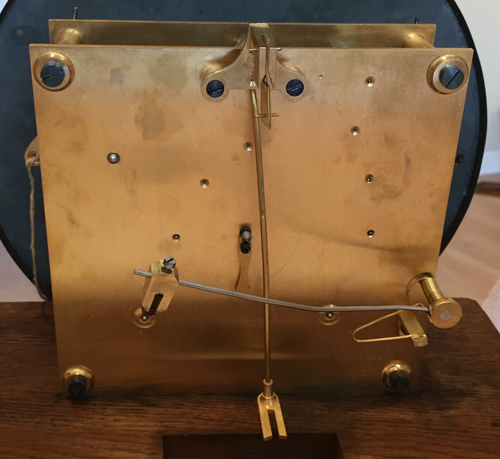
What I did find interesting was the adjustable pallet escapement. Usually, the anchor, which is tied to the pendulum and moves back and forth engaging with the escape wheel, is one piece of brass. The two pallet faces interact with the teeth of the escape wheel locking it place and then receiving an impulse to force the anchor – and thereby the pendulum – to arc back and forth.

The escapement of this clock has pallets that can be adjusted and easily replaced. However, there is nothing easy or simple with escapements, they are the heart of the clock and amateurs, such as myself, should not really fiddle with them. An escapement with adjustable pallets is like having a car where you only need to replace parts of the transmission and not the whole unit. The adjustable and removable pallets mean that the anchor could potentially be modified to work in other clocks with different escape wheels and pendulum lengths.
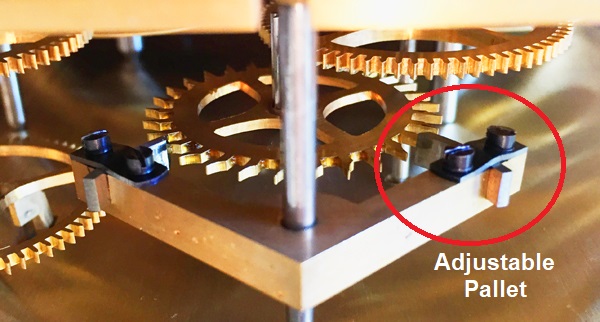
Because the clock movement has no manufacturer markings, my guess is that the company who built this clock bought movements from different sources. This is a very common practice for clock manufacturers. It is difficult to specialize in all aspects of clock manufacturing. Some manufacturers are known for their movements, while the case makers are virtually anonymous. Then there are other manufactures that focus on case design, but outsource the clock movements. One example is the Howard Miller clock company teaming up with George Nelson to design many iconic mid-century modern clocks. The actual clock movements were from Germany.
Clock Collectors of History
Some clock collectors focus solely on the movements, the case design is secondary or not considered at all. Other collectors are after particular types of clocks that fall into specific case categories such as banjo, ogee, acorn, or tall case clocks. While I am fascinated with the clock movement, I am equally drawn to the design elements. I appreciate a clock case designer who merges a specific architectural movement or influence, while at the same time working to create a piece of furniture that appeals to the consumer.
The clock case is a reflection of consumer demand at the time of the design. When you purchase a piece of furniture that directly references the architectural influences of the time period, you are making a statement. You are voting in favor of the design and the architectural influences behind it.
At the time this tall case clock was manufactured for the consuming public, large tall case or grandfather clocks were still in demand. While communities were beginning to be connected to electricity – making weight and spring driven clocks obsolete in terms of daily time keeping – many homes still relied on mechanical clocks. Clocks, especially tall case clocks, were a piece of furniture. This art nouveau clock, by an unknown maker, was a product of its age.
I would love to know if this clock and its design were successful or a flop. Did consumers in the market for such a piece of furniture find the design appealing or awful? Unfortunately, my inability to find many examples of similar art nouveau influenced tall case clocks suggest that this type of non-tradition case was not embraced by consumers. Another tall case that was equally non-conforming was the arts and crafts or mission style inspired clocks. A variety of different manufactures made this type of open case clock. In addition, there are many clock collectors who seek out this specific design inspired clock.
March 2020: I was contacted by one collector of art nouveau clocks in Texas who speculates that the dial and possibly the case are from the Vienna Secession movement and that the clock could have been manufactured as late as the early 1920s.
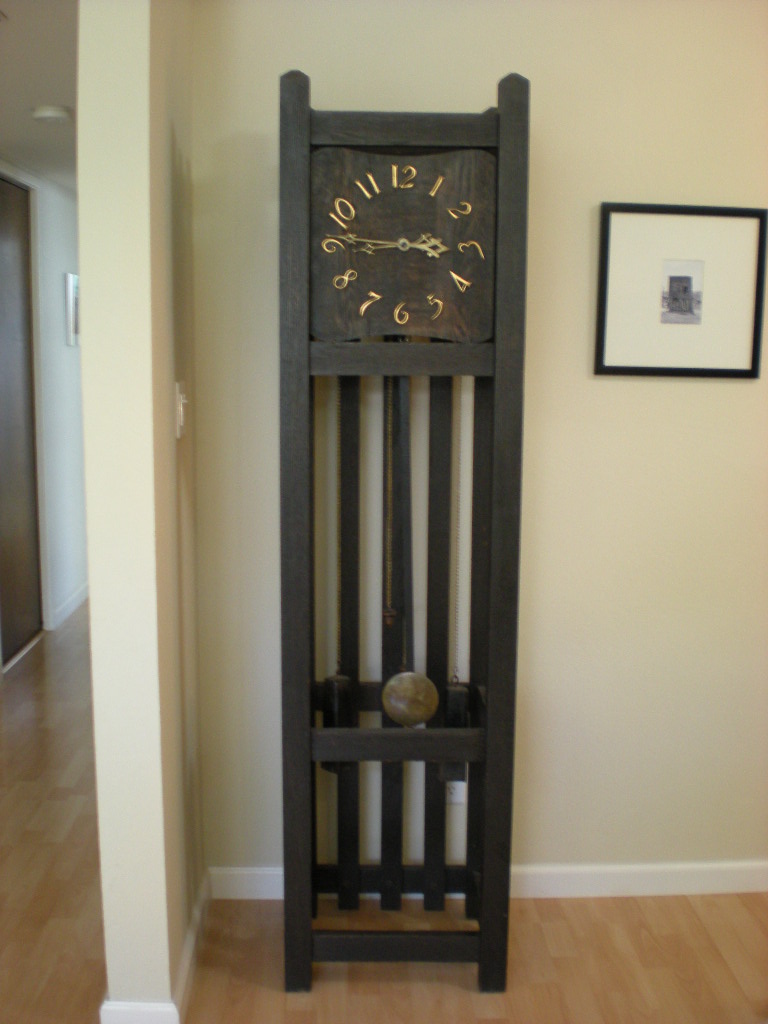
Mission style arts and crafts tall case clock 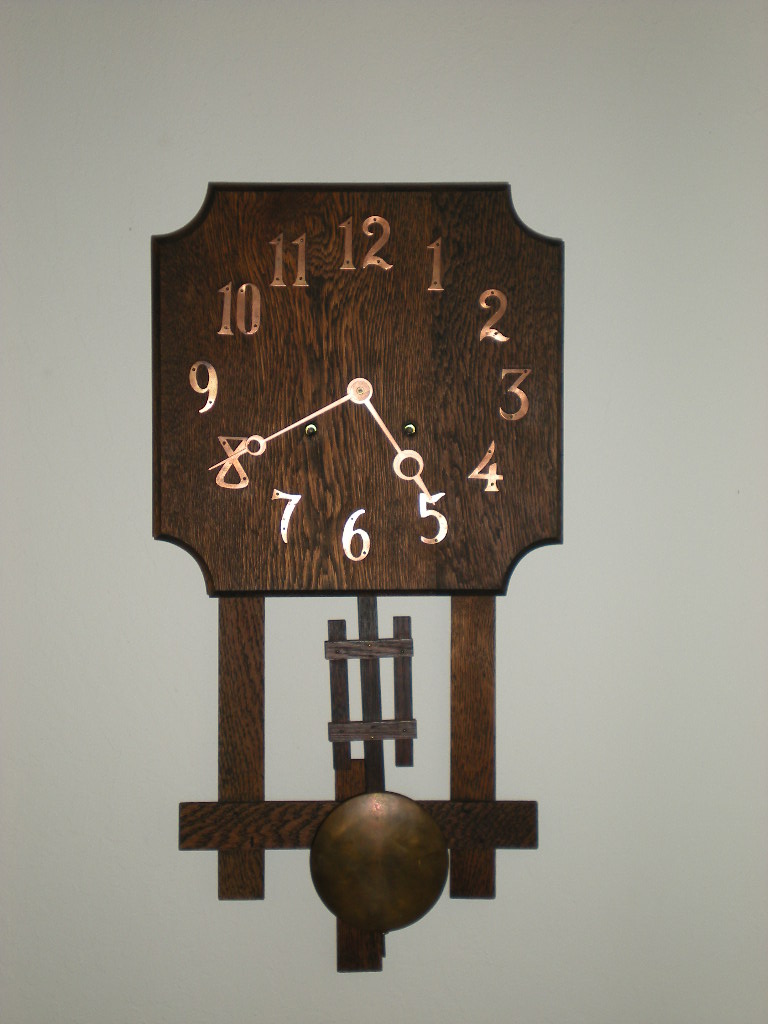
Arts & Crafts Wall Clock, first clock I restored, 8 day time and strike. 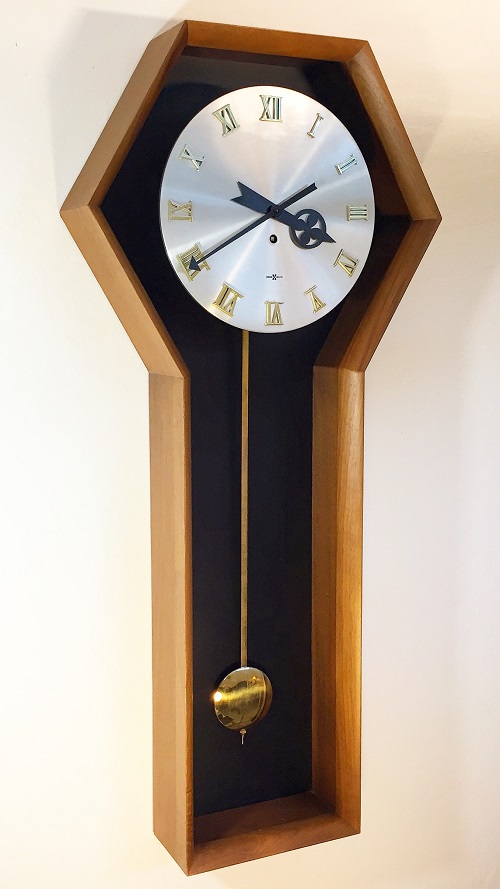
Coffin Clock, designed by George Nelson for Howard Miller of Zeeland, Michigan, model 557 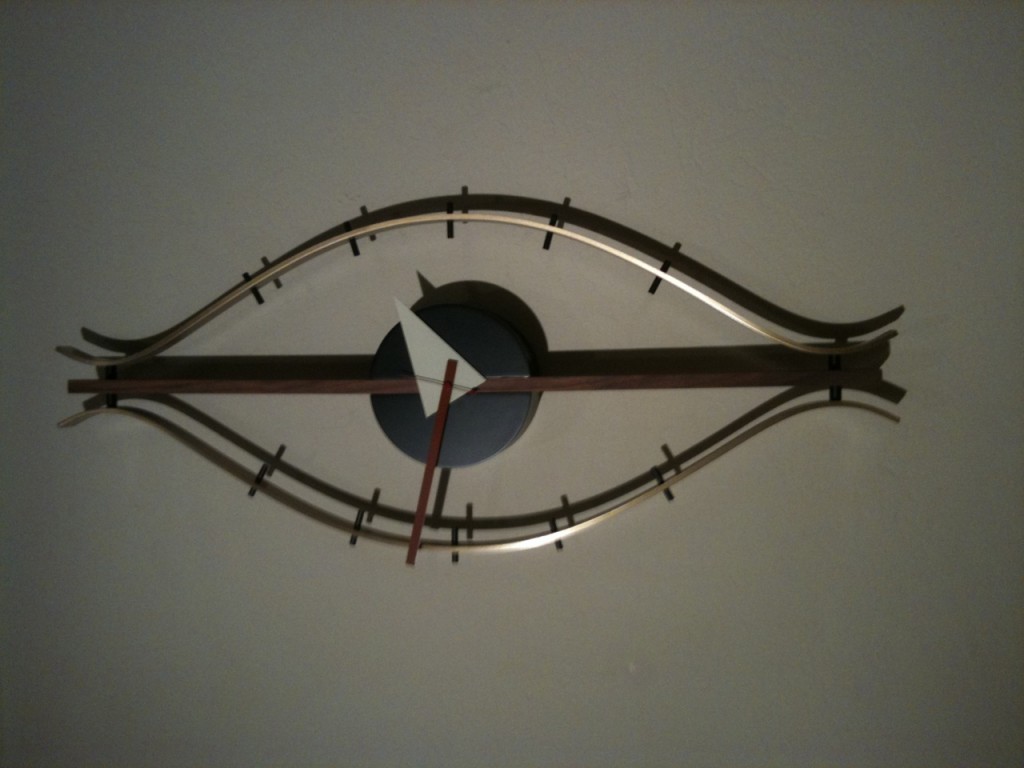
Reproduction George Nelson Eye clock
I’m very happy with my unknown art nouveau influenced tall case clock. If I ever come across another one, I might just buy it also. You can check out some of my other clocks on my House and Clock page.


